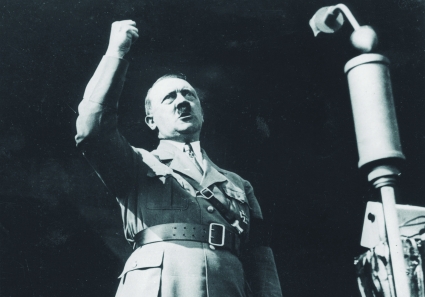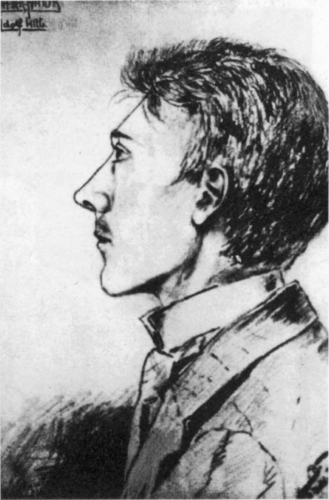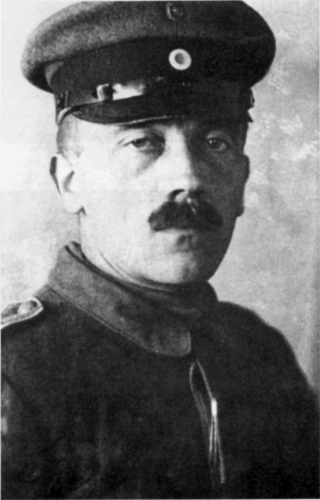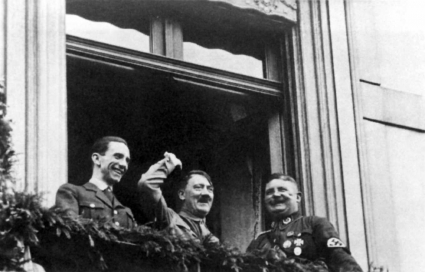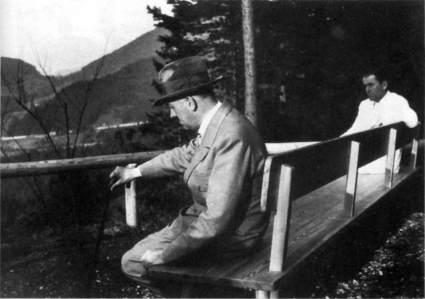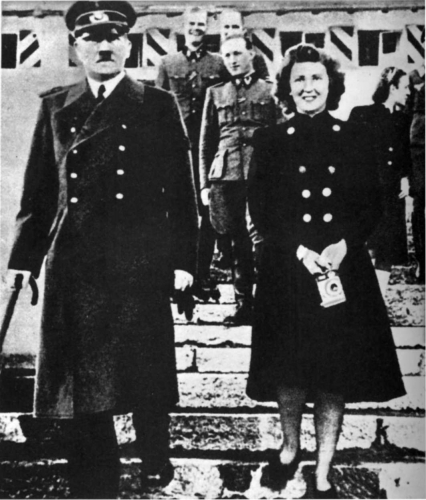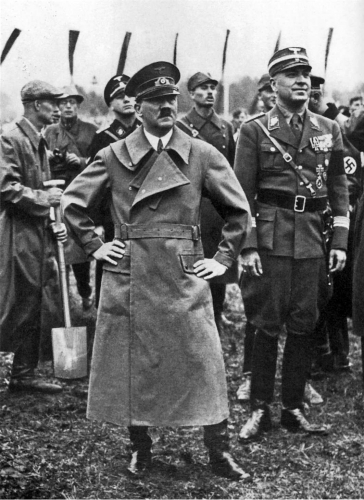A new biography in Swedish about Adolf Hitler (1889–1945) was published last year [1], written by the author and historian Bengt Liljegren. While reading the book, one is struck by how many examples are given of autistic problems in Hitler's life. The image of a man with Asperger's syndrome (AS) is growing stronger. The idea is not new and has been summarized in book form before [2]. The present article argues that Adolf Hitler may have had Asperger's syndrome. Biographical information and quotations are, unless otherwise stated, from Liljegren [1].
Adolf Hitler's father, Alois Hitler, was a zealous customs official who always followed the regulations closely. A co-worker described him as "strict, meticulous, downright pedantic." Other reviews were "unsympathetic", "inaccessible" and "difficult to cooperate with". "At the tavern he would always have the last word" and he "erupted slightly". He chastised his children regularly and demanded absolute obedience from them. Family life, however, was neglected; Alois was a devoted beekeeper and preferred to pursue his great interest.
Hitler's mother, Klara, was a cousin of her husband Alois. She is described as submissive, caring and a loving mother. The bonds between mother and son Adolf became strong, and he possibly got a special position in the sibling group.
At the age of six, Adolf Hitler started school. He had an easy time, and in the first years he received top marks in all subjects. In 1900 he started high school in Linz. Demands increased and grades dropped. Hitler lacked friends, daydreamed and did not read his homework. The teachers agreed that he "was decidedly talented, albeit single-minded, but had difficulty controlling his temper". His class teacher, Eduard Huemer, said in 1923 of his former student that he was "reluctant, arbitrary, assertive and hot-tempered" and "it was apparently difficult for him to adapt to the school framework". "Teaching and exhortation were not infrequently received with ill-concealed reluctance, but he demanded unconditional submission from his comrades." The studies were selective: "I learned only what I liked," Hitler later said.
The young Adolf Hitler was stubborn. His mother complained: "He goes his own way, just as if he were alone in the world." And: "He does not listen to anyone. He is as bald as his father… «. There was also another image of the young Hitler: "As a young man he was quiet, well-mannered and neatly dressed," testified the family's Jewish doctor, Eduard Bloch. "To a very large extent, this boy lived within himself. I do not know what his dreams were. ”As a thirteen-year-old, he lived with five other boys who were accommodated with an elderly lady in the city of Linz to get close to school. Hitler, however, kept mostly to himself, reading and drawing. One of the boys remembered: "While we were of course telling you to each other, he addressed us with you, and we also told you to him and found nothing strange in it. «The summer holidays during Hitler's sixteenth year were spent with relatives in Spital. His cousin Johan Schmidt said that Hitler kept to himself, drew and painted, wandered around and tried to learn to play the zither. "In my youth, I was more of a stranger who went by himself than a man who needed company," Hitler said in recent years.
There is no evidence of violence, animal cruelty or bullying by the young Hitler.
The monologue was Hitler's main form of verbal communication. Conversation in the usual sense did not amuse him [33]. Already as a teenager he held endless monologues.
Hitler never seems to have had a close relationship with a woman of the same age. At all, it is uncertain whether he even had any sexual intercourse. He had always had a hard time approaching the opposite sex. Over the years, things got easier. His first girlfriend, 16-year-old Maria Reiter, met Hitler in 1926. He was then 37 years old. The few relationships Hitler had were with very young women and entirely on his terms. "There is nothing more wonderful than raising a young girl - a girl of 18, 20 years is soft as wax," he once said. Eva Braun was only 17 years old when she met the 40-year-old Hitler. Albert Speer could sometimes be embarrassed on her behalf because of the insensitive way Hitler treated her. In front of his closest acquaintances, and with Braun by his side, he could say: "Very intelligent people should get a primitive and stupid woman. Imagine if I had a wife who put in my work! When I'm free, I want to be calm. I would never be able to get married… «
He would later claim that he had overcome the need to physically own a woman. "Germany is my mistress," he said. Another quote that illustrates Hitler's relationship to women and to the spoken language: "The masses are a woman, and I force it to obey me as such."
Hitler had no close friend. No one brought him into life. "He never heard about my family or friends, or what I liked to read, what was important to me or what I did not like," Leni Riefenstahl said in her memoirs. "The only thing he talked about was his ideas. That is why he became a stranger to me in his heart. "
He still got along well with children and older women, albeit on a superficial level. He especially referred to women of the maternal type. As a dictator, he liked to show himself in the company of children, but Albert Speer told of Hitler that "he never found the right unreserved way to spend time with them and after a few benevolent words he soon turned to something else."
Speer describes the amusement in "Diary of Spandau" about how excessively chivalrous Hitler behaved in society, which could cause embarrassment in the environment. Hitler's language in the salons never ceased to amaze Speer: "Highly honored, gracious wife!" Speer quotes from memory, "what a joy to be able to greet you again in your dear house in the best of health. With my everlasting esteem for you and your esteemed brother, I at the same time associate a wish that you allow me, on the occasion of this visit, to convey a modest gift, an extension of this tradition-laden home donated by me «[34].
Early in his career, Hitler's ascetic traits had worried some party comrades: "He does not smoke, he does not drink, he eats almost nothing but green fodder, he does not touch women! How should we present him to outsiders? ”He repeatedly preached the praises of vegetarianism and could call guests at his table" eaters "when they ate meat. During a dinner, he described in detail a visit to a slaughterhouse. Earlier, during the First World War, he could masterfully point out the dangers of tobacco and alcohol to his comrades who repeatedly risked their lives on the battlefield.
As a child, Hitler enjoyed playing wars. "War games, always just war games," summed up a comrade. When his peers got tired, he found younger children to play with. Still a fifteen-year-old, he played cowboys and Indians. Literature was an early interest. As a child he read adventure classics, but above all he became attached to Karl May's Western books, which he continued to read even during his time as Chancellor. All his life he devoured books. The emphasis was on non-fiction.
Hitler had strong interests, which dominated his life. Some were short-lived, others came to last a lifetime. Film was a lifelong interest, cars another even though he never learned to drive. The interest in opera - especially Wagner - had aroused in Hitler already when he, as a sixteen-year-old together with his only friend, Kubizek, saw Richard Wagner's Rienzi. Opera became the most important thing in Hitler's life after he in his late teens failed to enter the Academy of Fine Arts in Vienna, where he moved to establish himself "as a great artist". In the libraries, Hitler energetically studied everything he could find about Wagner's life and music. "His passion and worship of Wagner almost took the form of religion," Kubizek said. The interest in music was otherwise narrow: opera and operetta were appreciated, but hardly chamber music and symphonies.
Ever since his teens, Hitler had had a burning interest in architecture. He could sit for hours trying to memorize details on the large 19th-century buildings along the parade ring Ringstrasse in Vienna. The architect Albert Speer, Germany's Minister of Armaments, testified that thirty years later, Hitler was still able to draw the large buildings around the Ringstrasse - the town hall, the parliament, the Hofburg and the museums - to a large extent from memory.
Hitler hated what he called "bread work" but was still forced to support himself during his years in Vienna. Thus he began to paint watercolors which were later sold in taverns. The repertoire was narrow with motifs mainly from urban environments with a focus on architecture. His strength was to depict buildings with meticulous detail. On the other hand, he was worse at portraying people; the few that appear in his art are consistently angular and lifeless.
Hitler was an art collector. The own collection contained over 7,000 works by artists such as Rembrandt, Rubens, da Vinci and Vermeer, masterpieces purchased privately, stolen or confiscated in occupied territories. He was also a bibliophile and book collector with several private libraries totaling over 16,000 volumes [35].
Already at school age, Hitler was fascinated by the concept of race. Comrade Josef Keplinger has told that Hitler once, out of appearance, divided the class into "Aryans" and "non-Aryans" at the door outside the classroom. It was not until the age of 30, however, that he would seriously embrace the senseless anti-Semitism that would result in the "final solution" to the "Jewish question."
There is no lack of routine in Adolf Hitler's life: wherever he spent the night, the same arrangement applied with three publications that would be on the bedside table and a photograph of the mother on the wall above the bed. The morning ritual included daily bathing and washing with a Steckenpferd-Lilienmilcht soap, shaving with two planers, smearing with Pfeilring skin cream and bathing the legs with hair water from the Dralles Birkenwasser brand. The toilet board took 22-23 minutes.
Breakfast lasted 3-5 minutes and always consisted of two cups of lukewarm milk, ten Leibniz Zwieback crusts and a third of a chocolate cake.
He refused to wear boots other than his old favorite pair. Only black low shoes were accepted, the valet Krause often presented shoes in other colors in vain.
Hitler had a hard time tolerating Eva Braun changing her hairstyle. »You look completely foreign, yes completely changed. You are a completely different woman! «He could exclaim disappointed when she put up her hair or dyed it. "I do not understand at all why you women have to change clothes all the time!" He said. »If I find a dress especially good-looking, I would like to see the owner of this dress all the time…«
Hitler's eyes have been described in different ways, often in adolescence it was precisely those people who noticed. The gaze could be penetrating, but a young woman clearly remembered "his shyness and his habit of lowering his gaze when talking to someone."
It is unclear whether Hitler can be said to have been clumsy or had deviant motor skills. It is clear that he did not play any sport, never swam outdoors, did not ski, did not want to try riding and did not take a driver's license, even though he was very interested in cars. "Dancing is an unworthy occupation for a statesman," he said.
It seems that Hitler had difficulty with body contact throughout his life. As a young man, he was difficult to wake up. His mother, however, came up with advice to get him out of bed: little sister Paula was sent up to give him a kiss, whereupon he went up like a shot. He hated being hugged and kissed. The photographer Heinrich Hoffmann has told about New Year's Eve 1924, which was celebrated with a party in the photographer's home. Hitler, a celebrity guest, was in a good mood until he was surprisingly kissed under the mistletoe by a brave young woman: "I will never forget the expression of surprise and horror on Hitler's face!" Hoffmann said. "Confused and helpless as a small child, Hitler stood there biting his lip in an attempt to contain his anger." Attempts were made to appease the 34-year-old leader, but he left the party offended.
It can be assumed that Hitler had reduced sensitivity to cold. He could walk around the mountains in his leader pants in minus degrees. Military discussions with the commanders took place at the map table in the study at the Wolfsschanze headquarters. The dictator liked to be cool - sometimes as cold as 10-12 degrees. The tall masters often had to stand with blue-frozen hands and red noses around the table. Hitler himself sat comfortably.
Many have testified to Hitler's extraordinary memory. His highly trained officers were often overwhelmed by Hitler's vast detailed knowledge. He could read whole pages from books by heart and thereby give the impression that it was his own opinion.
An astonishing example of (certainly youthful) naivety and lack of mentalizing ability is Adolf Hitler's love of Stefanie Isak. The soon-to-be 17-year-old Hitler had seen her during one of his walks on the streets of his hometown of Linz. For four years no other girl existed for him, and he wrote countless love poems dedicated to her. She was completely unaware of his existence as they never met, never exchanged a word. When he was about to apply to the Academy of Fine Arts in Vienna, he wrote to her and asked her to wait for him; he would come back and marry her. However, Hitler never signed the letter.
Adolf Hitler has few similarities in world history in terms of crimes against humanity. His life course became rarely malignant. He probably met the criteria for a number of psychiatric diagnoses, not least a severe narcissism. The discussion about the emergence of the dictator's boundless brutality is beyond the scope of this article.
Although Hitler's monomaniacal anti-Semitism could be understood in the light of a pervasive developmental disorder, it is in no way an explanation for his crimes against humanity.
What suggests that Adolf Hitler was found on the autism spectrum is the following: the father exhibited symptoms that may indicate autistic problems, with strictness, pedantry and "inaccessibility". He also had cooperation difficulties, aggression problems and a narrowly defined interest (in beekeeping). Hitler himself showed early evidence of one-sidedness in communication, difficulties in relating to peers, socially and emotionally inappropriate behavior, and engrossing special interests. He was a collector. Evidence is available for early tendencies to formal and pedantic language. Hitler was also a person whose idiosyncratic routines affected both his own and others' lives. Deviating sensors are coated. Motor clumsiness to some extent can not be ruled out. The memory capacity was remarkable, as was the detailed thinking.
Based on information from Bengt Liljegren's biography of Adolf Hitler, he is judged to have met the criteria for Asperger's syndrome according to ICD-10 and DSM-IV-TR. However, he can only be said to have had a subclinical syndrome according to the criteria of Gillberg and Gillberg [12] and Szatmaris [15], respectively.
Asperger's syndrome - a syndrome with many symptoms
Asperger's syndrome is a constellation of symptoms and characteristics that cause difficulties in social interaction, a limited ability to communicate and limited interests or activities. In addition, deviations in sensory and motor skills are seen to varying degrees. AS belongs to the group of autism spectrum disorders and is mainly hereditary [3,4]. Most researchers agree that the condition describes autism in people with moderate to very high intelligence. No one today can say for sure how common it is.
There are at least five different criteria-based manuals available for diagnosing AS [5]. These are partly mutually exclusive. Recognized important features such as deviations in sensory science are not found in any set of criteria [6, 7].
Another diagnostic problem is that no description of AS in adults has yet been sought in the recognized diagnostic manuals. The descriptions of the syndrome in these are mainly based on four case presentations by the Austrian pediatrician Hans Asperger and thirty-four by Lorna Wing, a well-known researcher in the field of autism and asperger's.
The majority of cases were children and adolescents, mostly boys [8, 9]. The problem is common with that in the diagnosis of AD / HD, where the criteria have also been developed for boys.
"Co-morbidity" AD / HD, Tourette's syndrome and obsessive-compulsive disorder can complicate diagnosis [10]. Accumulated mental illness such as addiction, anxiety syndrome and not least affective illness can further obscure the viewer's vision [7, 10]. High intelligence and talent can "protect" both against difficulties and against correct diagnosis and understanding.
Women with AS rarely correspond to the stereotype. They often get the wrong diagnosis / s. Half of children with the syndrome are not diagnosed [10]. In adults, the proportion is probably even higher.
Although the clinical picture may vary infinitely, the following are common: social problems, stubbornness, and eccentricity of at least one close relative; own peer problems in childhood and difficulties in school, often despite high talent. Stubbornness is common, as is a tendency towards perfectionism, at least in one's own areas of interest. A mild mindset is not uncommon but neither is aggression. Habits are included in the picture as well as the immersive special interests, often one or a few at a time, which can last from weeks to half a century.
Deficiencies in communication can take many different forms, but there is usually a tendency towards one-sidedness: one speaks to others rather than to others. A tendency to monologize is not uncommon. Difficulty seeing things from other people's perspectives is also part of the picture, as is a lack of ability to compromise.
Intellectual interests are common. The lack of common sense can sometimes be a striking contrast to general intelligence. Characteristic is also, for better or worse, the tendency to see details at the expense of the ability to see the whole. Many have an exceptional ability to accumulate external knowledge. Collecting is common at all.
The person with AS often does not know how to behave in contexts that are not explicitly formalized: mingling and cold talk are experienced as highly anxious and are often avoided. For many with AS, the unwritten rules for social interaction are illogical and difficult to understand. Some find security in science with its legality,
others in law or mathematics. A few are attracted by fundamentalist teachings, where black and white, good and evil are clearly separated and where clear messages are given about what is right and what is wrong.
Many with AS have difficulty with emotional and physical intimacy. Sexuality is often problematic.
It is important to emphasize that the adult high-functioning person with AS often learns to hide and compensate for the deviations from the normal [6].
Sensory abnormalities are thus common, such as hypersensitivity or hypersensitivity to temperature, sound, light, smell, taste and touch. Body contact is experienced by some as very unpleasant. Deviating motor skills are also common: the asperger criteria according to Gillberg and Gillberg require motor clumsiness for diagnosis [12], while ICD-10 states that such is common but not necessary for diagnosis [13]. The DSM-IV-TR makes no mention of the matter [14], nor does Szatmari [15].
Characteristics associated with AS are seen in many important people in history, not least researchers but also many composers, writers, philosophers, artists and the occasional director, politician and king. The characteristics in the context are perseverance, the ability to think in unorthodox paths, narrow-mindedness, tendency to systematize facts, perfectionism, detailed thinking and the ability / tendency to prioritize distractions such as social interaction.
Thus, a number of famous historians have been suspected of having Asperger's syndrome, such as Isaac Newton, Charles Darwin, Albert Einstein, Marie Curie, Ludwig van Beethoven, Eric Satie, HC Andersen, George Orwell, Spinoza, Immanuel Kant, Ludwig Wittgenstein, Michelangelo, Vincent van Gogh, Andy Warhol, Stanley Kubrick, Charles de Gaulle, Lenin and Charles XII [16-23].
Even some extremely destructive people, such as serial killers such as the American Jeffrey Dahmer and others, have been suspected of having AS [24-26]. Perpetrators of school massacres have in a couple of cases presented behavioral profiles that led to thoughts of autism spectrum disorders or AS. The link between the syndrome on the one hand and crime and violence on the other is controversial and still essentially unexplored [27-32].
DIAGNOS POST MORTEM. Adolf Hitler's personality and consequently biography show features and details that led more and more specialists to suspect that the dictator of Nazi Germany was a man with Asperger's syndrome. Photo: Scanpix
DRAWN BY FRIEND. The teenage friend and roommate Alfred Kubizek was drawn by Adolf Hitler when they lived together in Vienna during the first years of the 20th century.
IN SERVICE AT THE FRONT. Corporal Adolf Hitler served as an ordinance on the Western Front during the First World War.
CROWNED OF SUCCESS. Adolf Hitler on his way to the culmination of his comet career. Here flanked by Joseph Goebbels and Ernst Röhm after the takeover in 1933.
DISTANCE TO OTHERS. Hitler liked to keep his distance from his fellow human beings. Not even the closest employee Albert Speer, on the right, came really close to him.
HITLER AND EVA BRAUN. Eva Braun was only 17 years old when she met the 40-year-old Adolf Hitler. She did not become Mrs. Hitler until in the bunker under Berlin just a few hours before the couple's joint suicide.
DICTATOR NOT ALONE. If Adolf Hitler had Asperger's Syndrome, he was by no means the only historical figure to have criteria for this diagnosis. A large number of statesmen, researchers and artists are on lists constructed by specialists in psychiatry.


